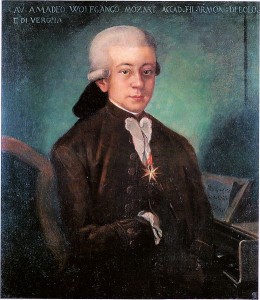Sonata “in the style of Mozart”
(More materials to come, but can be used as is!)
Introduction
This project enables young students to come to terms with the complexities of sonata form in a creative and manageable way.
Derived from a simple aural analysis made by 14 year olds of a movement from a Mozart piano sonata using uncomplicated words and terminology, a template is presented in which students need only to compose seven short melodic fragments to produce a convincing sonata form exposition. There is no need to use a computer at all for this project, but sequencing software certainly helps: (a) to link the 7 fragments in a way which does not overwhelm the students; (b) to enable the teacher to suggest all manner of further possiblities by annotating interim print outs; (c) to ease the non-pianist into working with effective and varied chordal accompaniments. Despite the fairly rigid template, students will take their own liberties and it is always astonishing to hear the variety of pieces which a class produces after a few weeks working at this project. Teachers may wish to listen to the examples of complete and partly complete movements linked at the end of this page to gauge what is possible.
2-5 No: 6-8 No: 9-11 No; 12-13 perhaps with occasional gifted students; 14-15 works well with a well-motivated class; 16-17 very suited; 18+ very suited
Expected prior achievements of students
- Students should be able to write short simple melodies in simple keys (C and G majors);
- understand both theoretically and practically what the primary (I, IV, V) chords are in these keys and have some experience applying them in accompaniments;
- compose a sequential phrase. Amphion presents many of these skills in the Villagers’ Dance, making this a very useful follow-on project.
Goals and aims of project
The aim of the project is to give students the opportunity of developing a large-scale and complex formal structure in a way which is neither inhibiting for them, nor dry.
By creating their own exposition section they will
- gain insight into the expressive potential of much Classical, Romantic and 20th Century music;
- have a basis for understanding large scale compositions through further listening;
- produce a final composition of imposing length, balance and complexity;
- be empowered to complete the development and recapitulation sections for themselves.
- Because this project is about understanding Classical style, not just composing ‘like Mozart’, the information pages (see below) have clear questions to support listening. Teachers would be well advised to have answers to the many open-ended questions before distributing these pages.
Project materials in text form
Preparatory notes for the teacher
Student Worksheets: click for
- html. format – – – for pdf. format: My Sonata Form Composition
- examples and analysis to support comparison of this to Mozart’s Sonata K309
Information sheets, full with musical illustrations, on:
- Classical Period and the Classical Style
- The Early Piano and the Piano Sonata
- The Sonata, String Quartet and Symphony
- Project materials in Music (performance) form
There are no MIDI files necessary to start this project. Students will be creating their own MIDI-file (or file in equivalent format).
For information and illustration, this sample of files shows students work (14/15 year-olds) in different stages of progress. Reference to the student worksheet is advised when reviewing them.
Finished Expositions
Al Mozart 1 (BAHUSI – pair work)
Al Mozart 2 (BABSICAT – pair work)
Al Mozart 3 (JROSS – individual work)
Stages in creating an exposition
Al Mozart 4 (CAIPON1 – 7 unlinked tracks. This will sound chaotic, unless you ‘mute’ and ‘solo’ the tracks in the sequencer)
Al Mozart 5 (CAIPON2 – First linking + some accompaniment ideas)
Al Mozart 6 (CAIPON3 – Finished exposition)
Full sonata movement (extended project)
Al Mozart 7 (ALDRIC – Exposition – Development – Recapitulation)
- Project materials in music (notation) form
The project requires no notated material. Interim print-outs as per the MIDI files 4, 5 & 6 above will help students, especially if teachers annotate them with comments and suggestions for improvement.
- Suggestions for working with the materials (including essential preparation)
See teacher preparation notes.
- Further materials
Worksheet for the “development”
Worksheet for the “recapitulation”
Information sheet on
- The Classical period and Classical style
- The Early Piano and the Piano Sonata
- The Sonata, String Quartet and Symphony
- Suggestions for following up the project including links to related music, books, sites etc.
What you would do next to consolidate what the students have learned?
Author John Mason
© John Mason

